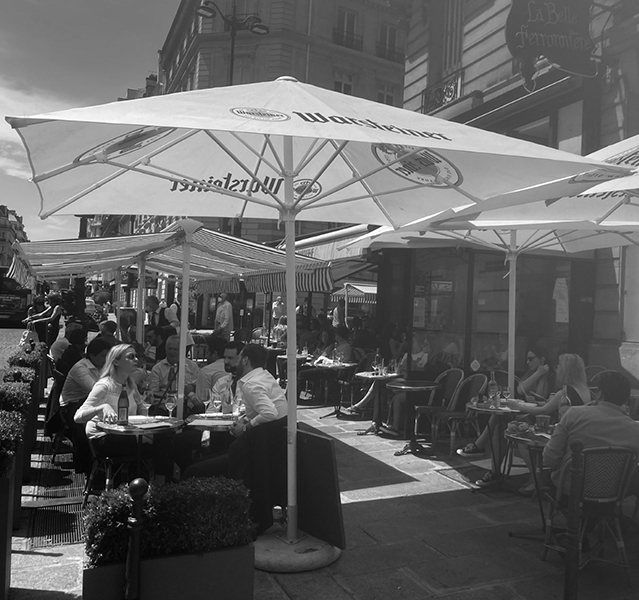The brasserie next to my office is a classic. A chalkboard shows the plats du jour. The waiters in crisp black waistcoats glide between tables. The corner terrasse catches the lunchtime sun. Customers watch the world from wicker chairs facing the street. Since Paris restaurants started re-opening a month ago, a sense of optimism is in the air. The return of my favourite local brasserie, La Belle Ferronnière, is a small example of the joys and the challenges of this unique moment in Paris.
Cafés and restaurants are the pulse of a city and their complete closure this winter showed that this is especially true of Paris. After 200 shuttered days in which that restaurant pulse was only kept ticking by takeaway food and government support packages, the gradual re-opening has even been likened to la libération in 1944. This new freedom has proved a very open-air event, helped by the authorities’ enforced rethink of Paris’s public space. Sixty thousand car parking spaces have been replaced with socially distanced outdoor tables and since the first Covid lockdown, no less than 10,000 ad hoc terraces have been created in Paris – many within makeshift wooden crate constructions. My local is on rue Pierre Charron, a wide street with elegant pavements which are now packed with improvised lunchtime tables of sashimi or Peking duck.Like the neighbouring restaurants, La Belle Ferronnière has carved out extra seating from the street, using both its delivery zone and tables on the vent of an underground car park.
La Belle Ferronnière (named after da Vinci’s painting The Ironmonger’s Daughter) defines itself as a brasserie authentique, since it stays open from 06.30 until the small hours. In more normal times, regular clients are boosted by tourist custom from hotels and film fans from cinemas on the nearby Champs Elysées. The cuisine is French, but not high gastronomy – rather it is simple, well prepared and well presented. Importantly, the food has the label fait maison (prepared on site), a quality control prompted by restaurants’ widespread reheating of pre-prepared frozen products. This brasserie’s breakfast croissant, for example, is made on the premises and is a thing of perfect balance: not too dry and flaky, not too buttery. The fresh béchamel sauce in the croque monsieur – a dish too often just reheated from the freezer – is another barometer of standards. The menu is built around incontournables (classicssuch as onion soup), plus a handful of plats du jour.
Customers are served by professionals who care. Behind the bar, Patricia has been serving noisettes here for 16 years and recalls precisely what her regulars order. Romain, the cheerful waiter from the south, prepares a sole meunière with a distinctive lilting accent. Jimmy, his eccentric colleague from Normandy, likes to practise country and Western singing when bringing coffee. The long-serving Frédéric cuts a distinguished figure with his colourful shirts and ties. Even behind a mask, he has a twinkle in the eye and generally greets me warmly (and ironically) as jeune homme.
“The pandemic is a well-recognised agent of change and has indeed altered things here”
Despite the masks, these professionals are happy to be back and have proved very resilient in recent times. In December 2018, their workplace was boarded up at weekends when gilets jaunes rioters ran from the Champs Elysées and smashed the brasserie’s old plate glass window. After general strikes in December 2019, coronavirus was the third in a trifecta of hard blows. The pandemic is a well-recognised agent of change and has indeed altered things here: plexiglass screens are on the bar, newspapers have disappeared from the press rack and individual bread rolls are replacing sliced baguettes. In this famously cash-is-king world, contactless card payments are now positively encouraged, while the now biodegradable paper menu comes with a QR code.
After the initial euphoria of re-opening, Lucas, the manager, says business is slow, pointing to new structural trends such as nearby office staff eating more lunches at home and the surge of the takeaway food culture with Uber Eats and Deliveroo. More temporary headwinds, such as evening curfews, missing international tourists and absent business travellers should blow away. He remains hopeful of the future when these short-term trends stabilise in a more ‘normal’ world, but in the here and now, Lucas feels that some people have simply forgotten the old habits of going out and eating out. Against a background of unmistakeable optimism in Paris, there is much food for thought on what happens next in the restaurant industry.







